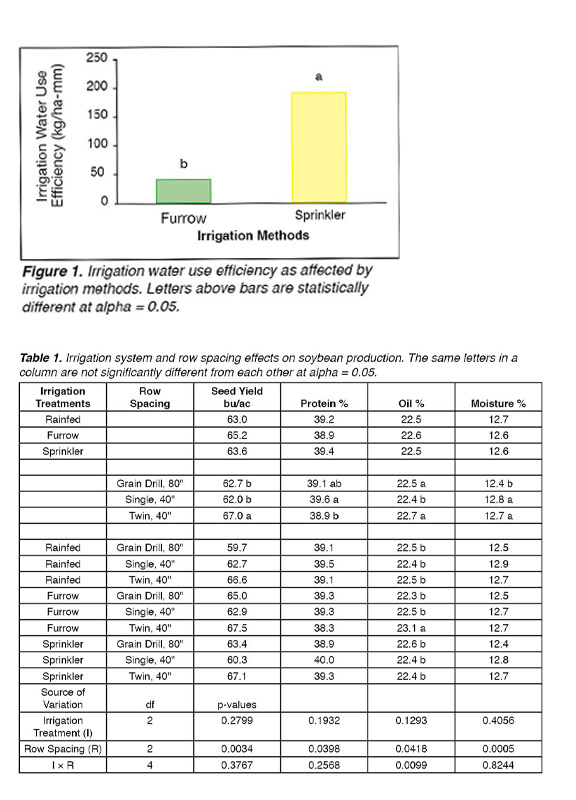Research Project
Irrigation Systems and Row Spacing Effects on Soybean Water Use and Yield Components
Investigators: Amilcar Vargas, Gurpreet Kaur, Gurbir Singh
Date: 2021
Project Summary
Introduction
Soybean in Mississippi is usually grown at 36- or 38-inches row spacing. Soybean production in narrow row spacing (< 36 inches) has been proven to be feasible practice to increase soybean yield and economic returns in the Midwest states. The explanation of this increase in seed yield on narrow rows has been associated with a better light interception, nutrients, and increased water use efficiency. Water management practices are needed in Mississippi to increase the irrigation water use efficiency for soybean production and at the same time reduce pumping rates of groundwater from the Mississippi River Valley Alluvial Aquifer (MRVAA). The objective of this research was to determine the effects of irrigation methods and row spacing on soybean agronomic characteristics, yield, irrigation water use, and water use efficiency in the Mississippi Delta.
Materials and Methods
This study was conducted at the Mississippi State University’s Delta Research and Extension Center on a Sharkey clay soil series. The field had a lateral move (Valley, Omaha, NE) irrigation system covering 38 acres. Extreme rainfall events limited access to the field in Fall 2020. This situation did not allow any tillage operations in fall 2020 therefore all tillage were performed in late spring 2021. Soybean variety AG 43x0 was planted on 5/27/2021 at the seeding rate of 140,000 seeds/ac. Soybean was planted in three-row patterns including 40” twin-row, 80” wide bed with six rows, and 40” single row spacing. Twin rows were planted with a Monosem NG Plus-4 8-row planter (Monosem Inc., Edwardsville, KS), single rows were planted with a John Deere 7300 4-row planter (John Deere, Moline, IL) and the 80’’ wide bed was planted with a Tye Grain Drill (The Tye Co., Lockney, Texas). All the planters and grain drill were calibrated for the seeding rate before planting. Irrigation treatments were rainfed, furrow, and sprinkler irrigation. Preplant application of 48 oz/ac Paraquat + 0.25% v/v Scanner was applied on 5/18/2021 for weed management. 22 oz/ac dicamba + 48 oz/ac Roundup PowerMAX 3 + 0.25% v/v Scanner + 8 oz/ac drift control compound was applied for post-emergence weed management on 6/29/2021. Soil moisture was monitored using Watermark 200SS sensors (Irrometer, Company Inc. Riverside, CA) installed at 6, 12 and 24 inches. Irrigation treatments were triggered when the weighted average of the three soil-moisture sensor readings were equal or greater than -80 centibars. Data collected included soil samples, plant population, seed quality and seed yield. Soybean was harvested on 10/12/2021. Seed quality analysis was performed in November 2021 to determine protein, moisture, and oil content using a Foss Infratec grain analyzer (Eden Prairie, MN). Statistical analysis was conducted for all the data using statistical analysis software (SAS 9.4; SAS Inc. Cary, NC). Mixed model analysis was performed using the GLIMMIX procedure and mean separations were performed using Fisher’s protected least significant difference test (p-value < 0.05).
Results and Discussion
There were significant differences in soybean yield, protein, oil, and moisture as affected by row spacing (Table 1). The highest yield (67 bu/ac) was achieved with a twin-row pattern at 40 inches row spacing. Irrigation water use efficiency (IWUE) was statistically different between furrow and sprinkler irrigation methods (Figure 1). The sprinkler irrigation method had the highest IWUE. These results indicated that IWUE efficiency can be improved using sprinkler irrigation method for soybean production in the Mississippi Delta and thereby can help with decreasing the water withdrawals for irrigation from MRVAA.
Project Photos

- Crop Type:
- Soybean
- Topic:
- Irrigation Scheduling
- Irrigation
Find Research
By Crop Type
By Topic
Contact NCAAR
General Information
Kaye Sullivan
vfs23@msstate.edu
662.390.8510
F:662.390.8501
Showcase Demo
Drew Gholson, Coordinator
drew.gholson@msstate.edu
662.390.8505
Himmy Lo
himmy.lo@msstate.edu
662.390.8509

